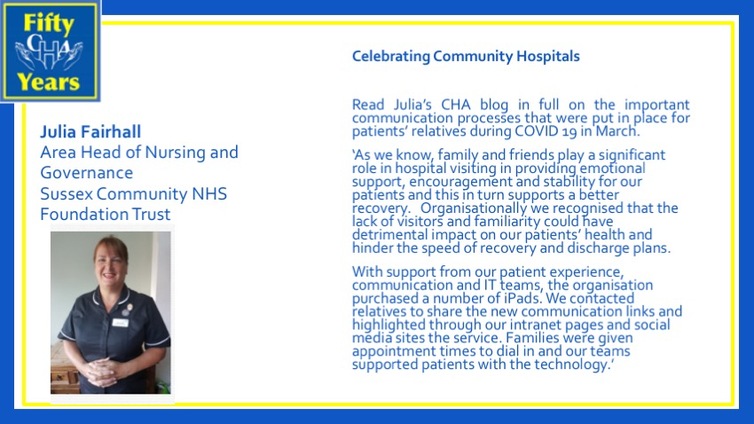
My role as Area Head of Nursing is to lead on aspects of professional practice, patient safety, quality, ensuring both clinical and professional standards are in place to deliver safe, effective, responsive care and quality care across the Central Area that is covered by Sussex Community NHS Foundation Trust.
An important component of my role is about visibility and there's nothing I enjoy more than being on the community wards catching up with our fabulous teams and this has been so important through Covid, touching base with our teams. In the area I cover, our culture is important and one of openness and transparency. Listening and spending time with our teams plays an essential part in how we all develop and problem solve together. This was key to our team being able to effectively work through the challenges we faced with the COVID-19 pandemic.
Within our wards we had a number of patients with Covid and had to follow national guidance regarding ceasing any visitors (apart from exceptional circumstances such as our end of life care patients) onto our wards. As we know, family and friends play a significant role in hospital visiting in providing emotional support, encouragement and stability for our patients and this in turn supports a better recovery. Organisationally we recognised that the lack of visitors and familiarity could have detrimental impact on our patients’ health and hinder the speed of recovery and discharge plans.
With support from our patient experience, communication and IT teams, the organisation purchased a number of iPads. We contacted relatives to share the new communication links and highlighted through our intranet pages and social media sites the service. Families were given appointment times to dial in and our teams supported patients with the technology.
We had the most amazing staff redeployed to support our ward teams and three of the redeployed team, Mary, Sacha, and Helen led a project to support patients to use both iPads and or mobile telephones to make contact with family and friends as part of a wellbeing project. It wasn’t an easy project for the team as they faced teaching family (some of whom were elderly themselves) how to set up Skype on a variety of systems depending what technology families had.
Feedback from staff and families:
“It’s given everyone involved a massive boost and if only we could have captured the smiles of joy on both patients and families. It lifted everyone’s spirits”
We had feedback from a son who lives in France who was able to talk with his father before he passed away who just said:
“Thank you so much for making this happen”
We also utilised the iPads for patients to watch the VE Day activities and to mark the national silence. We also recognised that families who were trying to contact the ward by telephone for information about a loved one often had long waits due to staff carrying out care delivery which they found frustrating. Therefore, appointment times really relieved stresses and we utilised these also for medical /nursing updates with families too.
We recognise this project had a huge impact on patient’s mood and health and wellbeing. We had so much positive feedback from our families that we will continue to utilise. As we know not all families live locally in the same communities. Families felt anxious about their family members in hospital and this made a huge difference to keeping families informed and part of the care planning.
